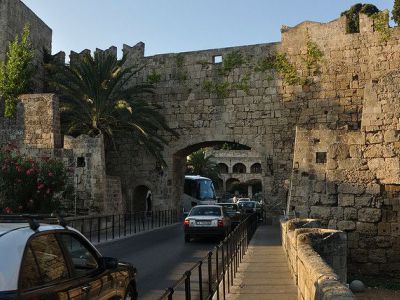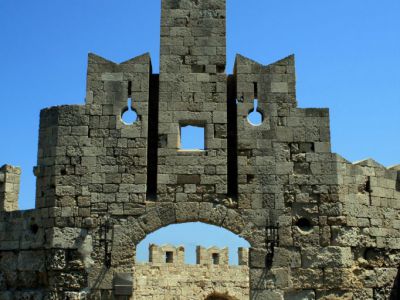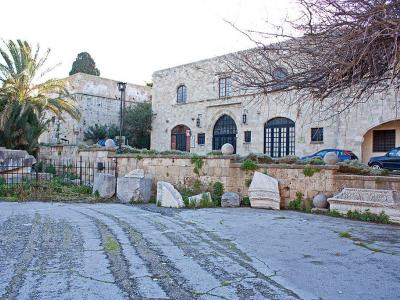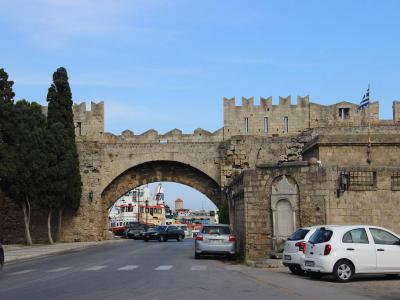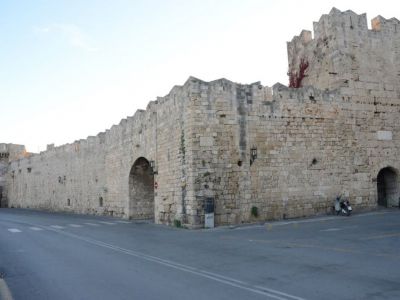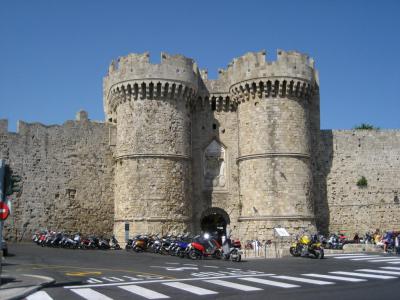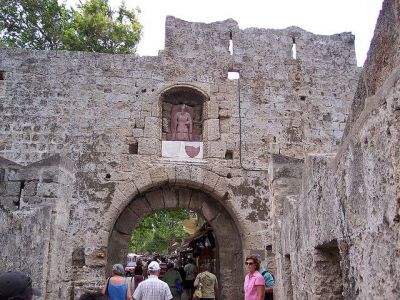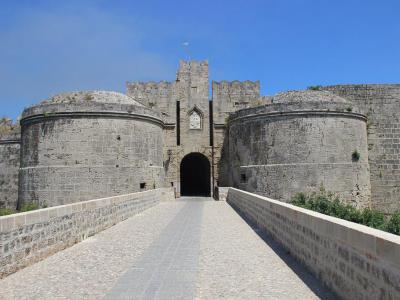Gates and Walls Tour (Self Guided), Rhodes
Owing to its geographical location, as a gateway to the Aegean Sea, Rhodes has always had a vantage position on trade routes between the West and the East – well protected against both foreign invaders and corsairs sailing the Mediterranean waters. The early defense system of Rhodes dates back as far as the 4th century BC.
Starting the Middle Ages – the year 1309, when the Knights Hospitaller of Saint John captured the island, these fortifications took the shape of a crescent, enhanced by the knights using the existing Byzantine walls.
The medieval walled city of Rhodes has been on UNESCO's World Heritage list since 1988. All together, this huge complex covers a distance of four kilometers and includes 11 gates, some of which are open to the public. Among the key highlights here are:
Eleftherias (Liberty) Gate – one of the Old Town's main entrances, built and named by the Italians in 1924 after “liberating” the island from the Ottoman rule in WWI.
Temple of Aphrodite – reminder of the splendors of ancient Greece; built in the 3rd century BC.
Tarsanas (Arsenal) Gate – the former passage through which the knights brought their weaponry into the citadel.
Arnaldo Gate – provides access to the former hospital of Saint John, now home to the Archaeological Museum.
Marine Gate – one of the medieval strongholds, situated near to the water; hence the name.
St. Anthony's Gate – aka the Saint Francis Gate; named after the nearby Saint Francis Church.
D'Amboise Gate – an imposing structure adjacent to The Palace Of The Grand Masters.
To explore these and other historic gates, towers and walls of one of the best-preserved medieval cities in Europe in more detail, take this self-guided walk.
Starting the Middle Ages – the year 1309, when the Knights Hospitaller of Saint John captured the island, these fortifications took the shape of a crescent, enhanced by the knights using the existing Byzantine walls.
The medieval walled city of Rhodes has been on UNESCO's World Heritage list since 1988. All together, this huge complex covers a distance of four kilometers and includes 11 gates, some of which are open to the public. Among the key highlights here are:
Eleftherias (Liberty) Gate – one of the Old Town's main entrances, built and named by the Italians in 1924 after “liberating” the island from the Ottoman rule in WWI.
Temple of Aphrodite – reminder of the splendors of ancient Greece; built in the 3rd century BC.
Tarsanas (Arsenal) Gate – the former passage through which the knights brought their weaponry into the citadel.
Arnaldo Gate – provides access to the former hospital of Saint John, now home to the Archaeological Museum.
Marine Gate – one of the medieval strongholds, situated near to the water; hence the name.
St. Anthony's Gate – aka the Saint Francis Gate; named after the nearby Saint Francis Church.
D'Amboise Gate – an imposing structure adjacent to The Palace Of The Grand Masters.
To explore these and other historic gates, towers and walls of one of the best-preserved medieval cities in Europe in more detail, take this self-guided walk.
How it works: Download the app "GPSmyCity: Walks in 1K+ Cities" from Apple App Store or Google Play Store to your mobile phone or tablet. The app turns your mobile device into a personal tour guide and its built-in GPS navigation functions guide you from one tour stop to next. The app works offline, so no data plan is needed when traveling abroad.
Gates and Walls Tour Map
Guide Name: Gates and Walls Tour
Guide Location: Greece » Rhodes (See other walking tours in Rhodes)
Guide Type: Self-guided Walking Tour (Sightseeing)
# of Attractions: 8
Tour Duration: 1 Hour(s)
Travel Distance: 1.4 Km or 0.9 Miles
Author: rose
Sight(s) Featured in This Guide:
Guide Location: Greece » Rhodes (See other walking tours in Rhodes)
Guide Type: Self-guided Walking Tour (Sightseeing)
# of Attractions: 8
Tour Duration: 1 Hour(s)
Travel Distance: 1.4 Km or 0.9 Miles
Author: rose
Sight(s) Featured in This Guide:
- Eleftherias (Liberty) Gate
- St. Paul's Gate
- Temple of Aphrodite
- Tarsanas (Arsenal) Gate
- Arnaldo Gate
- Marine Gate
- St. Athanasios (St. Anthony's) Gate
- Gate d'Amboise
1) Eleftherias (Liberty) Gate
Sitting right in front of Symi Square, otherwise known as Place de l’Arsenal, is one of the main entrances into the medieval city of Rhodes – the Liberty Gate. The original gate on this site dates back to the time of Grand Master Heredia (1377-1396) and used to link the northern flank of the seaside wall to the Mandraki Harbour. Back then it was also colloquially referred to as the Shipyard Gate or Shipyard Vaults, being a short distance from the local arsenal and the knightly shipyards that formed part of the domain of the Langue (Tongue) of France.
Two square towers that once flanked the gate on both sides were razed by the Ottomans in 1910. Historic records indicate that one of them appears on the coat of arms of Grand Master d'Aubusson (1476-1503). The structure shows a pronounced influence of Byzantine architecture, and its dimensions (9.9 meters wide, 5.2 meters high) support the projected use of the passage – letting through voluminous vessels or appurtenances thereof en route to the shipyard. Under Ottoman rule, this gate may have also operated as a bridge over the water to a basin designated in Turkish as "Eğri Liman" ("Concealed Harbour").
The ramparts currently seen on top of the wall were erected during Italian rule (1912-1943). The Italians, who deserve much credit for historical reconstruction in Rhodes, created this gate in 1924 after they had taken possession of the island during WWI. Portraying themselves as liberators from the Ottoman rule, they called it Liberty Gate. Although modern as such, it was built in a strict accordance with medieval architectural practice.
Two square towers that once flanked the gate on both sides were razed by the Ottomans in 1910. Historic records indicate that one of them appears on the coat of arms of Grand Master d'Aubusson (1476-1503). The structure shows a pronounced influence of Byzantine architecture, and its dimensions (9.9 meters wide, 5.2 meters high) support the projected use of the passage – letting through voluminous vessels or appurtenances thereof en route to the shipyard. Under Ottoman rule, this gate may have also operated as a bridge over the water to a basin designated in Turkish as "Eğri Liman" ("Concealed Harbour").
The ramparts currently seen on top of the wall were erected during Italian rule (1912-1943). The Italians, who deserve much credit for historical reconstruction in Rhodes, created this gate in 1924 after they had taken possession of the island during WWI. Portraying themselves as liberators from the Ottoman rule, they called it Liberty Gate. Although modern as such, it was built in a strict accordance with medieval architectural practice.
2) St. Paul's Gate
Southeast of Mandráki Harbour, a scenic walk along the waterfront leads you through Saint Paul's Gate, an outer defensive bastion of the Old Town. This gate opens up at the northwest end of Kolóna, the central of Rhodes' three ports, buzzing with activity from colorful fishing boats, ferries arriving from Turkey, cruise ships, and large catamarans.
The bastion at the gate showcases expert construction techniques and serves as a point of reference for fortification experts: it features twelve cannon holes strategically positioned to cover a broad range between the two harbors and the mole of Saint Nicholas ("Agios Nikolaos"). A common element between this gate, the Saint Athanasius Gate, and the D'Amboise Gate is the drawbridge mechanism, believed to have operated through a system of beams and counterweights. Evidence of this system is visible in the vertical slots on the external wall, where the drawbridge beams would have been mounted.
Inside the semi-cylindrical tower on the inner wall, there's a marble sculpture displaying the coat of arms of the House of Grand Master d’Aubusson (1476-1503), adjacent to those of the Hospitallers Order and Pope Sixtus IV. Below these emblems is an effigy of Paul the Apostle and an inscription in Gothic characters reading "Sanctus Paul". These heraldic symbols date the completion of this section of the fortifications to around 1477, during a broader initiative led by Grand Master d’Aubusson to restore the northern walls.
During World War II, Saint Paul's Gate sustained significant damage and nearly collapsed, but was rebuilt in the early 1950s. Today, one of the best spots to appreciate the views is from the foundations of the now-gone Naillac Tower, just east of the gate. This location offers unparalleled views of Mandráki, especially at dawn and dusk, making it a favorite spot for both locals and visitors.
The bastion at the gate showcases expert construction techniques and serves as a point of reference for fortification experts: it features twelve cannon holes strategically positioned to cover a broad range between the two harbors and the mole of Saint Nicholas ("Agios Nikolaos"). A common element between this gate, the Saint Athanasius Gate, and the D'Amboise Gate is the drawbridge mechanism, believed to have operated through a system of beams and counterweights. Evidence of this system is visible in the vertical slots on the external wall, where the drawbridge beams would have been mounted.
Inside the semi-cylindrical tower on the inner wall, there's a marble sculpture displaying the coat of arms of the House of Grand Master d’Aubusson (1476-1503), adjacent to those of the Hospitallers Order and Pope Sixtus IV. Below these emblems is an effigy of Paul the Apostle and an inscription in Gothic characters reading "Sanctus Paul". These heraldic symbols date the completion of this section of the fortifications to around 1477, during a broader initiative led by Grand Master d’Aubusson to restore the northern walls.
During World War II, Saint Paul's Gate sustained significant damage and nearly collapsed, but was rebuilt in the early 1950s. Today, one of the best spots to appreciate the views is from the foundations of the now-gone Naillac Tower, just east of the gate. This location offers unparalleled views of Mandráki, especially at dawn and dusk, making it a favorite spot for both locals and visitors.
3) Temple of Aphrodite
The Temple of Aphrodite, or rather the remains thereof, located on Symi Square, outside the Eleftherias (Liberty) Gate in the Old Town of Rhodes, serves as a reminder of the splendor of ancient Greece that it once was. The sanctuary dates from the 3rd century BC and was built in honor of Aphrodite, the mythological Greek goddess of love and beauty. Venerated by ancient worshipers, her statue, currently in the Archaeological Museum of Rhodes, is believed to have once stood here.
Today the ruins of the formerly majestic temple are surrounded with a small fence. While the site is closed to the public, an information board outside the fence offers a detailed overview of the complex. The descriptions here are written in both Greek and English.
Those determined to have a glimpse of the place's former glory may get close enough to see the old building blocks and fallen columns. Some may even be able to make out some inscriptions on a couple of the flagstones.
Today the ruins of the formerly majestic temple are surrounded with a small fence. While the site is closed to the public, an information board outside the fence offers a detailed overview of the complex. The descriptions here are written in both Greek and English.
Those determined to have a glimpse of the place's former glory may get close enough to see the old building blocks and fallen columns. Some may even be able to make out some inscriptions on a couple of the flagstones.
4) Tarsanas (Arsenal) Gate
Just a stone's throw away from the Temple of Aphrodite, in the north-eastern part of the Old Town, is Tarsanas Gate ("Pili Tarsana" in Greek), also known as the Gate of the Arsenal, built by Juan Fernández de Heredia, who was the appointed Grand Master of the Knights from 1377 until his death in 1396. His coat of arms is displayed here, right at the top of the gate.
Back in the day, the knights' arsenal was located between the gates of Saint Paul and Saint Catherine, and had direct access to the port. The Arsenal Gate got its name from the fact that through this passage the knights used to carry their weapons, munition and other military equipment into the citadel.
In 1908, to widen the access road to the Kolona Harbour, the Ottoman administration demolished the two side towers flanking the gate. As a result, today's Arsenal Gate allows a fast flow of vehicles between the Kolona Harbour and the new city, and also provides a direct link from the Old Town to the Commercial Harbor.
Back in the day, the knights' arsenal was located between the gates of Saint Paul and Saint Catherine, and had direct access to the port. The Arsenal Gate got its name from the fact that through this passage the knights used to carry their weapons, munition and other military equipment into the citadel.
In 1908, to widen the access road to the Kolona Harbour, the Ottoman administration demolished the two side towers flanking the gate. As a result, today's Arsenal Gate allows a fast flow of vehicles between the Kolona Harbour and the new city, and also provides a direct link from the Old Town to the Commercial Harbor.
5) Arnaldo Gate
Further south of the Tarsanas Gate is this gate, called Arnaldo – a small entrance that allows access to the hospital of Saint John, now home to The Archaeological Museum. Part of the Marine Gate complex, constructed under Grand Master d'Aubusson, it provides exit from the Old Town to the Commercial Harbor.
Up until the second half of the 14th century, this passage is believed to have connected the main dock of the medieval port to the urban quarter of the City of Rhodes. According to a relevant written document from 1391, it was traditionally used by knightly novices (Filii Arnaldi) to enter the city. In later references, the gate is also referred to as the "Middle Gate" or the "Castellania Gate".
The Arnaldo Gate showcases the Provence style, similar to that of Saint Catherine's Gate, aka "the Gate of the Mole". That is a small wonder, however, given that all the Grand Masters in office during the construction of such passageways (from 1309 to 1373) originated from the Provence region of France. One of the two square towers designed to guard the gate, the one on the east side, crumbled after the 1481 earthquake. The interior of its western counterpart was later remodeled into a chapel, named Saint George ("Agios Georgios"). Outside it bears the coats of arms of Grand Master Juan Fernández de Heredia (1377-1396) and his second-in-command, Pierre de Culant. On the southern flank there are also the coats of arms of the Grand Masters Hélion de Villeneuve (1319-1346) and Giovanni Battista Orsini (1467-1476). The latter, in particular, was responsible for widening the gate in the 15th century.
Up until the second half of the 14th century, this passage is believed to have connected the main dock of the medieval port to the urban quarter of the City of Rhodes. According to a relevant written document from 1391, it was traditionally used by knightly novices (Filii Arnaldi) to enter the city. In later references, the gate is also referred to as the "Middle Gate" or the "Castellania Gate".
The Arnaldo Gate showcases the Provence style, similar to that of Saint Catherine's Gate, aka "the Gate of the Mole". That is a small wonder, however, given that all the Grand Masters in office during the construction of such passageways (from 1309 to 1373) originated from the Provence region of France. One of the two square towers designed to guard the gate, the one on the east side, crumbled after the 1481 earthquake. The interior of its western counterpart was later remodeled into a chapel, named Saint George ("Agios Georgios"). Outside it bears the coats of arms of Grand Master Juan Fernández de Heredia (1377-1396) and his second-in-command, Pierre de Culant. On the southern flank there are also the coats of arms of the Grand Masters Hélion de Villeneuve (1319-1346) and Giovanni Battista Orsini (1467-1476). The latter, in particular, was responsible for widening the gate in the 15th century.
6) Marine Gate
Just south of Kolóna's fishing port, the Marine Gate stands as a dramatic entry point into the walled town of Rhodes, complete with two large round towers. This gate is where visitors arriving by sea enter the city, providing a grand first impression. Built in 1478 during the era of the Knights Hospitaller, it was designed to imitate the Gate to Villeneuve-lès-Avignon in France, which dates back 200 years earlier.
The exterior features several reliefs, including one of the Virgin holding Christ, and others featuring Saint John the Baptist and Saint Peter. One can also spot the coats of arms of France, the Order of Saint John, and the blazon of the House of d'Aubusson. On the interior side, additional relief work includes an effigy of an angel with the coats of arms of the Order of Saint John.
Strategically built close to the water, the gate's positioning and the narrow space between the sea and the walls made it difficult for any army, regardless of size, to gather and launch an attack from this side; moreover, the towers were equipped with devices designed to pour boiling oil on any possible attackers. The gate was last restored in 1951, following repairs to the north tower, which had been damaged during World War II bombings.
The exterior features several reliefs, including one of the Virgin holding Christ, and others featuring Saint John the Baptist and Saint Peter. One can also spot the coats of arms of France, the Order of Saint John, and the blazon of the House of d'Aubusson. On the interior side, additional relief work includes an effigy of an angel with the coats of arms of the Order of Saint John.
Strategically built close to the water, the gate's positioning and the narrow space between the sea and the walls made it difficult for any army, regardless of size, to gather and launch an attack from this side; moreover, the towers were equipped with devices designed to pour boiling oil on any possible attackers. The gate was last restored in 1951, following repairs to the north tower, which had been damaged during World War II bombings.
7) St. Athanasios (St. Anthony's) Gate
A popular historic entrance to the walled city of Rhodes, this gate is habitually referred to by locals as Saint Francis' Gate due to the church of Saint Francis of Assisi, built by the Italians in the first part of the 20th century, located just outside. As for the gate itself, judging by the coat of arms displayed above the entrance, it dates back to the times of Grand Master Jean de Lastic (1437-1454), and came into being as a result of the modification to the part of the wall near D'Amboise Gate. The round tower of Saint Mary, designed to guard the gate, dates from the same period (1441).
Under the rule of Grand Master Pierre d’Aubusson (1476-1503), two bulwarks came to reinforce the fortification around the Gate of Saint Athanasius, giving the stocky bastion its actual, massive outlook. Right above the opening of the drawbridge there is the coat of arms of the House of d'Aubusson seen along with the inscription "hoc antemurale", reminiscent of the commissioning of the bastion in 1487.
Following the Ottoman conquest of Rhodes in 1522, the victorious troops of Sultan Suleiman the Magnificent marched through this gate into the city. An inscription in Farsi quotes reinstatement works of part of the bulwarks commissioned by the Ottoman Governor Abdülcelil, in the wake of the fall of Rhodes into the hands of the Ottomans.
This gate was subsequently closed by the Sultan in a bid to prevent any further conqueror from passing through it, ever. It was only re-opened, by the Italians, in 1922 to mark the 400th anniversary of the Ottoman conquest of the city and the island.
Under the rule of Grand Master Pierre d’Aubusson (1476-1503), two bulwarks came to reinforce the fortification around the Gate of Saint Athanasius, giving the stocky bastion its actual, massive outlook. Right above the opening of the drawbridge there is the coat of arms of the House of d'Aubusson seen along with the inscription "hoc antemurale", reminiscent of the commissioning of the bastion in 1487.
Following the Ottoman conquest of Rhodes in 1522, the victorious troops of Sultan Suleiman the Magnificent marched through this gate into the city. An inscription in Farsi quotes reinstatement works of part of the bulwarks commissioned by the Ottoman Governor Abdülcelil, in the wake of the fall of Rhodes into the hands of the Ottomans.
This gate was subsequently closed by the Sultan in a bid to prevent any further conqueror from passing through it, ever. It was only re-opened, by the Italians, in 1922 to mark the 400th anniversary of the Ottoman conquest of the city and the island.
8) Gate d'Amboise
Set in the northwestern corner of the Medieval City of Rhodes, the imposing D'Amboise Gate is undoubtedly one of its most remarkable structures, at least from a military standpoint, featuring a hugely fortified path with two gigantic round towers set to fend off any attack. Although the Ottomans eventually did manage to pass through it, they still couldn't enter the city right away, as the knights had modified the fortification so that three more gates, specifically added nearby, also had to be cleared in order to get in.
The D'Amboise Gate is found near The Palace of the Grand Masters, and bears the name of Grand Master Emery d'Amboise (1503-1512), in whose charge it was built in 1512. In fact, the actual construction started under his predecessor, Grand Master d'Aubusson (1476-1503), whose initial idea was to incorporate two earlier gates in this place, namely those of the Overseer and Saint Anthony.
Proportionate to its vital role, which was to defend the highly important yet vulnerable entrance from the west, along with the nearby Palace, the gate features a number of sizable halls for the guards. Niched above its arched entrance is the image of an angel brandishing the coat of arms of the Order, as well as that of the House of d'Amboise, along with the inscription "D'AMBOISE M. DXII (1512)".
Amid the havoc sown by the devastating earthquake of 1513, Grand Master del Carretto (1513-21) commissioned the gate's reconstruction, completed under the last Grand Master of the Order on the island, Villiers de l'Isle-Adam (1521-22). As the most elaborate piece of fortification in Rhodes, the gate bears witness to the opulence and power of the Order preceding the Ottoman invasion in 1522.
The D'Amboise Gate is found near The Palace of the Grand Masters, and bears the name of Grand Master Emery d'Amboise (1503-1512), in whose charge it was built in 1512. In fact, the actual construction started under his predecessor, Grand Master d'Aubusson (1476-1503), whose initial idea was to incorporate two earlier gates in this place, namely those of the Overseer and Saint Anthony.
Proportionate to its vital role, which was to defend the highly important yet vulnerable entrance from the west, along with the nearby Palace, the gate features a number of sizable halls for the guards. Niched above its arched entrance is the image of an angel brandishing the coat of arms of the Order, as well as that of the House of d'Amboise, along with the inscription "D'AMBOISE M. DXII (1512)".
Amid the havoc sown by the devastating earthquake of 1513, Grand Master del Carretto (1513-21) commissioned the gate's reconstruction, completed under the last Grand Master of the Order on the island, Villiers de l'Isle-Adam (1521-22). As the most elaborate piece of fortification in Rhodes, the gate bears witness to the opulence and power of the Order preceding the Ottoman invasion in 1522.
Walking Tours in Rhodes, Greece
Create Your Own Walk in Rhodes
Creating your own self-guided walk in Rhodes is easy and fun. Choose the city attractions that you want to see and a walk route map will be created just for you. You can even set your hotel as the start point of the walk.
Rhodes Introduction Walking Tour
The city of Rhodes, capital of the eponymous island, has been famous since antiquity as the site of one of the Seven Wonders of the World, the Colossus of Rhodes. The enormous statue once stood over the harbor entrance and was destroyed by a powerful earthquake in 226 BC.
The name Rhodes comes from the ancient Greek word “rhódon” (rose), hence the island is sometimes referred to as the... view more
Tour Duration: 2 Hour(s)
Travel Distance: 2.1 Km or 1.3 Miles
The name Rhodes comes from the ancient Greek word “rhódon” (rose), hence the island is sometimes referred to as the... view more
Tour Duration: 2 Hour(s)
Travel Distance: 2.1 Km or 1.3 Miles
Medieval Town Walking Tour
The medieval town of Rhodes, where every street, square, or building evokes a story about ancient times, is a living museum in its own right. Being one of the best-preserved medieval walled towns in Europe, this enchanting area boasts several remarkable locations and is quite deservedly declared a UNESCO World Heritage Site.
Welcoming you at its entrance is the Liberty (or Eleftherias) Gate.... view more
Tour Duration: 2 Hour(s)
Travel Distance: 1.9 Km or 1.2 Miles
Welcoming you at its entrance is the Liberty (or Eleftherias) Gate.... view more
Tour Duration: 2 Hour(s)
Travel Distance: 1.9 Km or 1.2 Miles
Mandraki Harbor Tour
Mandraki, one of the three harbors of Rhodes, is by far the most famous of them. For centuries, this “front door” of the island has welcomed visitors to Rhodes from far and away. In large part (and quite literally so), the reason for its popularity was the enormous statue of Colossus, one of the Seven Wonders of the Ancient World, that used to crown the harbor's entrance, adding a sense... view more
Tour Duration: 1 Hour(s)
Travel Distance: 1.0 Km or 0.6 Miles
Tour Duration: 1 Hour(s)
Travel Distance: 1.0 Km or 0.6 Miles
Acropolis of Rhodes
The Acropolis of Rhodes on Monte Smith is an ancient archaeological site. The excavations and restoration works here began under the Italian administration of the island (from 1912 to 1945) and continue to this day. This historic location is home to several significant structures dating back to the Hellenistic period (3rd to 2nd century BC) offering a glimpse into the history and culture of the... view more
Tour Duration: 1 Hour(s)
Travel Distance: 1.5 Km or 0.9 Miles
Tour Duration: 1 Hour(s)
Travel Distance: 1.5 Km or 0.9 Miles
The Most Popular Cities
/ view all



